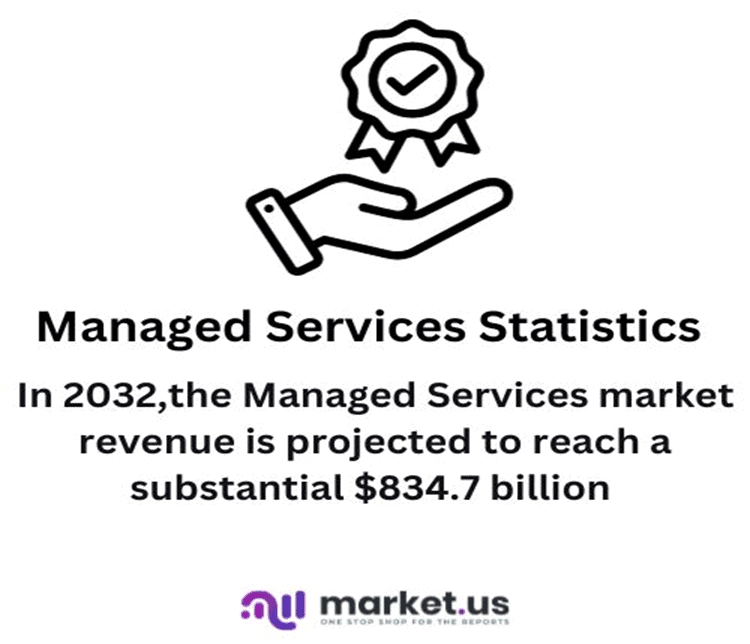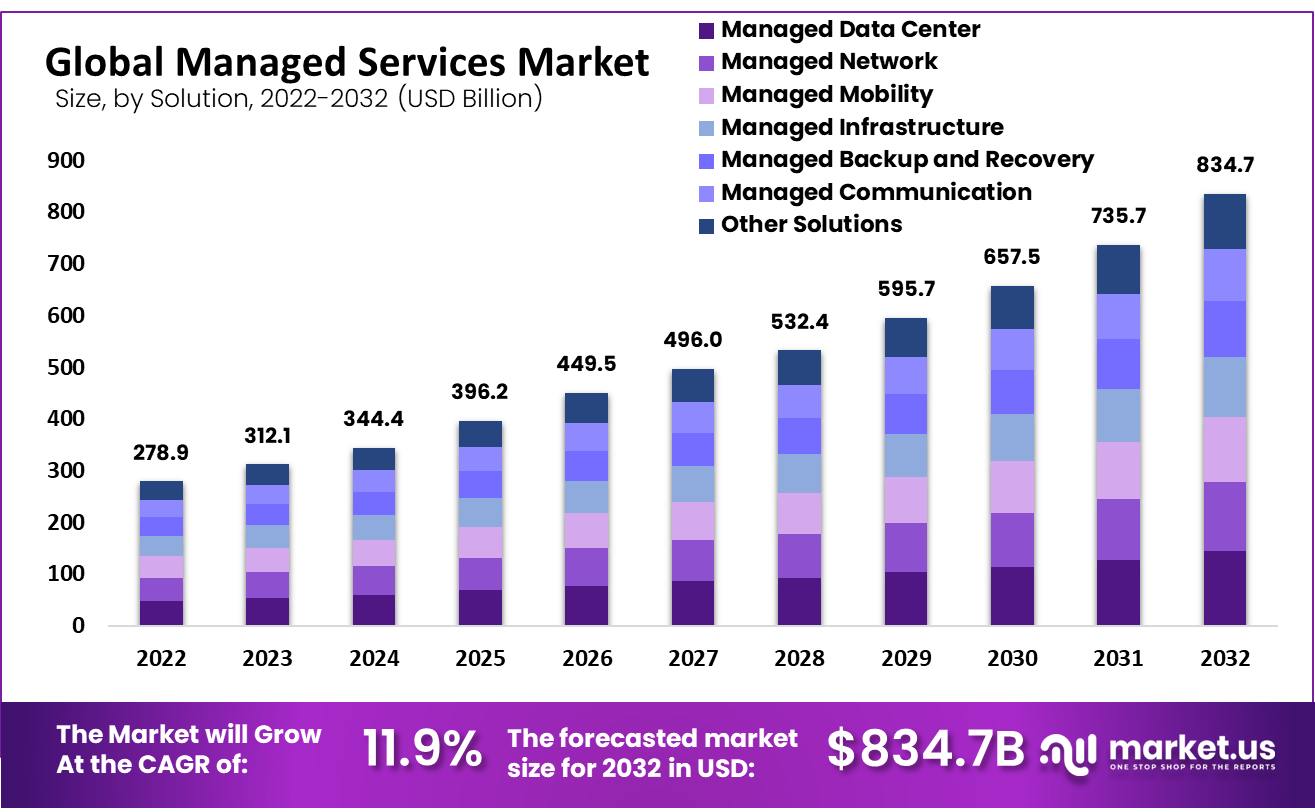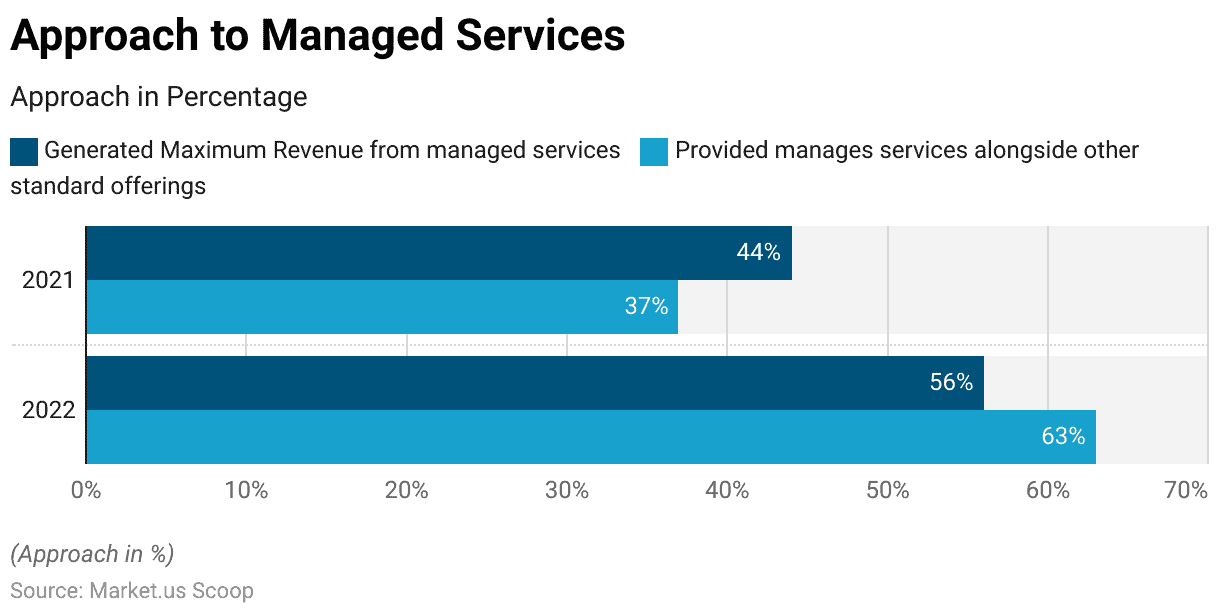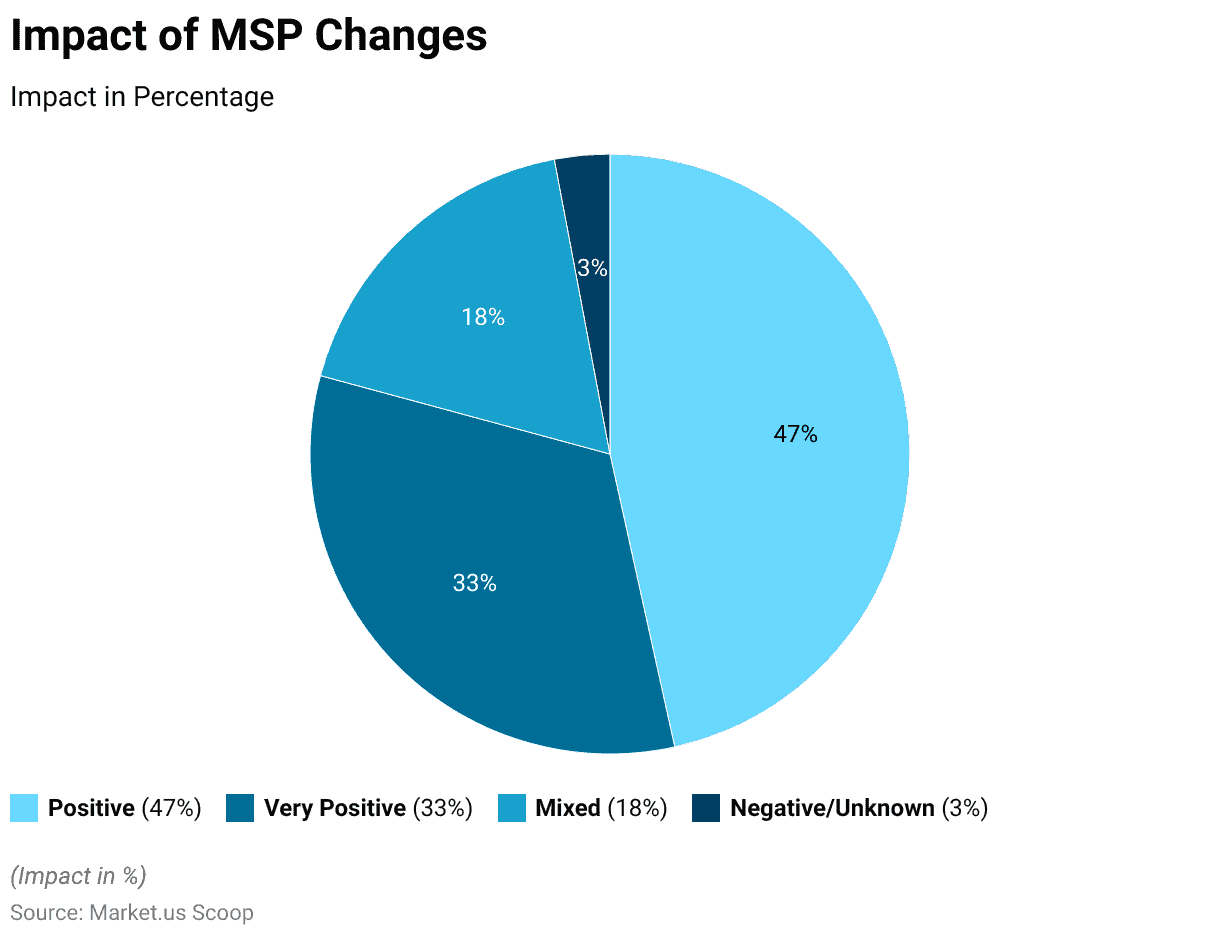Table of Contents
- Introduction
- Editor’s Choice
- Managed Services Provider Market Size Statistics
- Managed Services Provider Market- By Solutions
- Managed Services Provider Business Statistics
- Managed Services Provider Statistics by Applications
- Managed Services Provider Statistics by IT Services
- Approach by Managed Services Provider Statistics
- Impact of MSP Changes
- Recent Developments
- Conclusion
- FAQs
Introduction
Managed Services Provider Statistics: Services involve outsourcing specific IT or business functions to a third-party provider, a Managed Service Provider (MSP).
These services encompass IT infrastructure management, cybersecurity, cloud services, and network management. Backup and disaster recovery, application management, help desk support, compliance and reporting, and more.
They offer benefits like cost control, scalability, access to expertise, and improved operational efficiency. Allowing organizations to concentrate on their core activities while ensuring their IT and business processes are effectively managed and secured.

Editor’s Choice
- In 2022, the managed services market size started at 278.9 billion and began its upward trajectory.
- The market’s remarkable growth trajectory culminated in 834.7 units in 2032.
- In 2022, the overall revenue stood at $278.9 billion, with various solution segments contributing significantly.
- By 2032, the overall market revenue is projected to reach a substantial $834.7 billion, showcasing consistent growth.
- Despite concerns about data security, around 78% of global companies have confidence in their outsourcing partners.
- The USA alone outsources more than 300,000 jobs annually, highlighting the enduring appeal of outsourcing for MSPs.
- The number of connected devices is skyrocketing, with expectations of 22 billion by 2025.
- It is estimated that by 2021, the global economic impact of cybercrime will exceed $6 trillion annually.
- In 2021, the maximum revenue from managed services accounted for 44% of the company’s total income.
Managed Services Provider Market Size Statistics
- In 2022, the market size started at 278.9 units and began its upward trajectory.
- Over the subsequent years, this growth continued, with the market expanding to 312.1 units in 2023 and 344.4 units in 2024.
- The trend persisted as the market reached 396.2 units in 2025 and continued its steady ascent. Hitting 449.5 units in 2026 and 496 units in 2027.
- The momentum carried into 2028, with the market size reaching 532.4 units and continued to grow. Culminating in a significant 595.7 units in 2029.
- The upward trend remained robust in 2030, reaching 657.5 units, and maintained its pace, achieving 735.7 units in 2031.
- The market’s remarkable growth trajectory culminated in 834.7 units in 2032.
- These statistics demonstrate a consistent and substantial increase in market size over the years. Reflecting the industry’s vitality and pivotal role in the modern business landscape.
(Source – Market.us)

Managed Services Provider Market- By Solutions
- The managed services market is poised for substantial growth in the coming decade. As indicated by the projected revenue figures from 2022 to 2032.
- In 2022, the overall revenue stood at $278.9 billion, with various solution segments contributing significantly.
- Managed Data Center services generated $48.2 billion, while Managed Network and Managed Mobility services accounted for $44.6 billion and $41.8 billion, respectively.
- Managed Infrastructure, Managed Backup and Recovery, and Managed Communication services also made substantial contributions. Amounting to $39 billion, $36.3 billion, and $33.5 billion, respectively. Other solutions in the market generated $35.4 billion in revenue.
- As we move into the future, the managed services sector is expected to expand considerably.
- By 2032, the overall market revenue is projected to reach a substantial $834.7 billion, showcasing consistent growth.
- Key segments such as Managed Data Centers, Managed Networks, and Managed Mobility services are expected to experience substantial growth. With revenues of $144.4 billion, $133.6 billion, and $125.2 billion, respectively.
- The market’s continued expansion reflects the increasing reliance on managed services across various industries and their critical role in managing data, networks, infrastructure, and communication systems.
- This growth trajectory underscores the importance of managed services in the evolving landscape of technology and business operations.
(Source – Market.us)
Managed Services Provider Business Statistics
- In today’s business landscape, cloud services have become pervasive, with nearly 94% of organizations contemplating or already utilizing cloud solutions like Office 365, AWS, and cloud backup to streamline their IT operations.
- The trend extends to small and medium-sized businesses (SMEs). Where approximately 71% foresee cloud services as integral to their future success.
- Outsourcing IT functions is a strategy adopted by almost half of businesses (49%), allowing their key personnel to focus on core business activities. While benefiting from specialized skills such as cybersecurity and disaster recovery without hiring in-house experts, as 46% of organizations asserted.
- Managed IT services offer round-the-clock monitoring, ensuring 99.99% network uptime and proactive issue resolution while mitigating the escalating costs and inefficiencies associated with aging IT equipment.
- Furthermore, they free up approximately 65% of IT budgets typically allocated to routine maintenance. Enabling businesses to allocate resources more effectively for growth and innovation.
- Leveraging big data, cloud technology, and mobile strategies can yield a remarkable 53% increase in business growth.
- Collaboration with Managed Service Providers (MSPs), like SysGroup, empowers businesses to optimize their IT infrastructure to support growth and innovation. It’s important to note that MSPs complement internal IT teams. Offering expertise in cloud infrastructure, network setup, and complex projects rather than replacing them.
- As 45% of UK businesses plan to increase IT spending by 10-20% in 2023 compared to the previous year. Managed IT services emerge as a flexible and customizable solution to meet evolving technological demands.
(Source – Sysgroup)
Managed Services Provider Statistics by Applications
MSP in Outsourcing
- Many large companies have realized that maintaining an in-house digital transformation team can be costly.
- The rapid changes in the digital sector make it hard to keep up. Smaller businesses often lack the resources for in-house support.
- As a result, outsourcing has become a significant growth area for MSPs.
- Despite concerns about data security, around 78% of global companies have confidence in their outsourcing partners.
- The USA alone outsources more than 300,000 jobs annually, highlighting the enduring appeal of outsourcing for MSPs.
(Source: Fortunly)
Take advantage of our unbeatable offer - buy now!

MSP in IoT and Blockchain
- The number of connected devices is skyrocketing, with expectations of 22 billion by 2025.
- However, harnessing IoT and Blockchain technologies requires specialized skills. Many companies lack these skills and knowledge.
- MSPs are stepping in to assist businesses in adopting these technologies and staying competitive. They can also identify knowledge gaps and optimize cloud-based strategies.
(Source: IoT Analytics)
Managed Services in Cybersecurity
- It is estimated that by 2021, the global economic impact of cybercrime will exceed $6 trillion annually.
- The frequency of cyberattacks is high, with an average of 39 attacks occurring every 39 seconds.
- Additionally, 1 in 3 emails sent to businesses is malicious, and 95% of cyberattacks are caused by human error.
- Data breaches in 2020 are expected to cost businesses an average of over $150 million.
- Furthermore, 60% of businesses affected by cyberattacks will likely cease operations within 6 months.
- Most Americans (56%) do not know what to do if their data is breached.
- small and medium-sized businesses (SMBs) experience an average of 8 hours of downtime due to cyberattacks, and 62% lack the necessary in-house cybersecurity skills.
- Finally, 21% of companies’ data folders are unprotected, making them accessible.
(Source – Cybercrime Magazine, Security, Quickstart, IBM Security Services, Jupiter, Bankinfo Security, SBDC Arizona, Varonis)
Managed Services Provider in Backup and Disaster Recovery Statistics
- Regarding Disaster Recovery Plans (DRPs), it’s concerning to note that only 21% of small and medium-sized enterprises (SMEs) have a comprehensive plan.
- This lack of preparedness is compounded by the fact that every minute of downtime imposes a significant financial burden, averaging around $5,600 for businesses.
- Data loss, a critical aspect of disaster recovery, is primarily attributed to hardware or system failures (31%), and human error (29%). The ever-present threats of viruses, malware, or ransomware (29%).
- Moreover, the expenses associated with data recovery can be staggering, often exceeding $7,500, and even then, success is not guaranteed.
- Alarmingly, a substantial portion of SMBs, approximately 58%. Test their disaster recovery plans just once a year or even less frequently, with 33% conducting infrequent or no testing at all.
- These statistics underscore the pressing need for businesses, especially SMEs. To prioritize and invest in robust disaster recovery strategies to safeguard their operations and mitigate the costs and risks associated with downtime and data loss.
(Source – Security Magazine, Gartner, Arcserve, Boston Computing Network, Complete Technology)
Managed Services Provider Statistics by IT Services
- A large portion of organizations, amounting to 94%, are either considering or have already put into place cloud-based solutions to improve their outsourcing strategies.
- Most small and medium-sized enterprises (SMEs) expect cloud services to become an essential component of their operations within the next five years, with 71% holding this belief.
- Regarding IT outsourcing, almost half of enterprises (49%) state that it enables them to allocate their limited resources more effectively to their primary activities.
- Similarly, 49% of enterprises report that outsourcing their IT functions helps direct their scarce resources to their core operations.
- Continuous monitoring of the network, ensuring 99.99% uptime, is possible 24/7.
- Managed IT services can reduce overall infrastructure costs, resulting in cost savings.
- It is estimated that a significant portion, approximately 65%, of IT budgets is allocated to maintaining existing systems and operations.
- Initiatives related to big data, cloud computing, and mobility contribute to a growth increase of 53%.
- Managed Service Providers (MSPs) do not pose a threat to your internal IT team.
- In the United Kingdom, 45% of businesses plan to increase their spending by 10% and 20% in 2023 compared to 2022.
(Source: Sysgroup)
Approach by Managed Services Provider Statistics
- In 2021, the maximum revenue from managed services accounted for 44% of the company’s total income.
- During that year, managed services were also provided alongside other standard offerings, constituting a slightly smaller portion at 37%.
- However, in 2022, there was a significant shift in the revenue structure. Managed services experienced substantial growth, contributing 56% of the total revenue. Indicating an upward trend in the company’s focus on these specialized services.
- Simultaneously, the provision of managed services alongside standard offerings increased significantly, accounting for 63% of the company’s business activities in 2022.
- This shift suggests that the company is increasingly emphasizing and expanding its managed services portfolio. Aligning with evolving market demands and customer preferences.
(Source -Sysgroup)

Impact of MSP Changes
- The impact of changes in Managed Service Provider (MSP) operations has been predominantly positive, with 47% of respondents reporting a positive outcome.
- A significant portion, 33%, expressed a very positive sentiment regarding the MSP changes, highlighting a high level of satisfaction and success in their implementation.
- However, a portion of 18% indicated mixed results, suggesting that while some aspects of the changes were beneficial, others may have posed challenges or uncertainties.
- Only 3% reported a negative or unknown impact, indicating that most respondents have seen tangible benefits from the alterations made to their MSP operations.
- Overall, these findings demonstrate a largely favorable response to the changes, with a notable contingent experiencing highly positive outcomes.
(Source – Sysgroup)

Recent Developments
Acquisitions and Mergers:
- IBM acquires Taos: In early 2023, IBM completed its acquisition of Taos, a cloud professional and managed services provider, for $200 million. This acquisition aims to enhance IBM’s hybrid cloud capabilities and expand its managed services offerings.
- Accenture acquires Linkbynet: Accenture acquired Linkbynet, a French cloud services provider, for $250 million in late 2023. This merger is expected to strengthen Accenture’s cloud-first capabilities and improve its managed services portfolio.
New Product Launches:
- Microsoft Azure Managed Services: In mid-2023, Microsoft launched an expanded set of Azure Managed Services, providing enhanced cloud management, security, and compliance features for enterprises, aimed at simplifying cloud operations and optimizing costs.
- AWS Managed Services Updates: Amazon Web Services (AWS) introduced new features to its Managed Services in early 2024, including improved automation, security, and compliance tools to help businesses manage their AWS environments more efficiently.
Funding:
- NTT Ltd. raises $500 million: In 2023, NTT Ltd., a global technology services provider, secured $500 million in funding to expand its managed services capabilities, focusing on enhancing its cloud, cybersecurity, and IT infrastructure services.
- Wipro secures $400 million: Wipro, a leading IT services company, raised $400 million in early 2024 to invest in its managed services portfolio, aiming to provide more comprehensive solutions for cloud migration, digital transformation, and IT management.
Technological Advancements:
- AI and Automation in Managed Services: AI and automation are increasingly being integrated into managed services to improve efficiency, reduce operational costs, and enhance service delivery through predictive maintenance and automated issue resolution.
- Enhanced Security Services: Advances in cybersecurity are being incorporated into managed services, offering improved threat detection, incident response, and compliance management to protect client data and IT environments.
Market Dynamics:
- Growth in Managed Services Market: The global managed services market is projected to grow at a CAGR of 8.1% from 2023 to 2028, driven by increasing demand for IT outsourcing, cloud adoption, and the need for specialized IT expertise.
- Increased Adoption Among SMEs: Small and medium-sized enterprises (SMEs) are increasingly adopting managed services to reduce IT costs, access advanced technologies, and focus on core business activities, contributing to market growth.
Regulatory and Strategic Developments:
- EU’s General Data Protection Regulation (GDPR) Compliance: Managed services providers are enhancing their offerings to ensure compliance with GDPR, providing data protection, privacy, and security solutions to meet stringent regulatory requirements.
- US Cybersecurity Executive Order: The US government’s cybersecurity executive order issued in early 2024 emphasizes the importance of securing IT services, driving managed services providers to adopt best practices in cybersecurity and risk management.
Research and Development:
- Cloud Management Platforms (CMPs): R&D efforts are focusing on developing advanced cloud management platforms that offer centralized control, automation, and optimization of multi-cloud environments, enhancing the efficiency and effectiveness of managed services.
- Next-Generation IT Support: Researchers are exploring the use of AI, machine learning, and natural language processing to develop next-generation IT support systems that provide proactive maintenance, intelligent ticketing, and personalized user experiences.
Conclusion
Managed Services Provider Statistics – The managed services sector demonstrates substantial growth potential from 2022 to 2032.
With revenues steadily increasing over this period, it is evident that businesses and industries are increasingly relying on managed services to handle critical aspects of their operations.
The market’s expansion is particularly noteworthy in segments such as data center management. Network services, and mobility solutions, reflect the evolving needs of a technology-driven world.
This data underscores the enduring importance of managed services in optimizing business performance and ensuring the efficient management of essential IT infrastructure and communication systems.
FAQs
Managed services refer to outsourced IT solutions and services provided by third-party providers to manage and maintain various aspects of an organization’s IT infrastructure and technology needs.
Managed services can include many offerings, such as network management, data center services, cloud computing, cybersecurity, helpdesk support, and more.
Businesses opt for managed services to reduce IT costs, improve system reliability and security, access specialized expertise, and allow their in-house IT teams to focus on strategic tasks rather than day-to-day maintenance.
Managed services pricing can be based on a subscription model, where businesses pay a monthly or annual fee, or it can be customized based on the specific services required.
Managed services provide proactive, ongoing monitoring and maintenance, whereas traditional IT support tends to be reactive, addressing issues as they arise.
Yes, managed services can benefit businesses of all sizes. Many providers offer scalable solutions tailored to fit the needs and budgets of small and medium-sized enterprises (SMEs).
Discuss your needs with our analyst
Please share your requirements with more details so our analyst can check if they can solve your problem(s)



